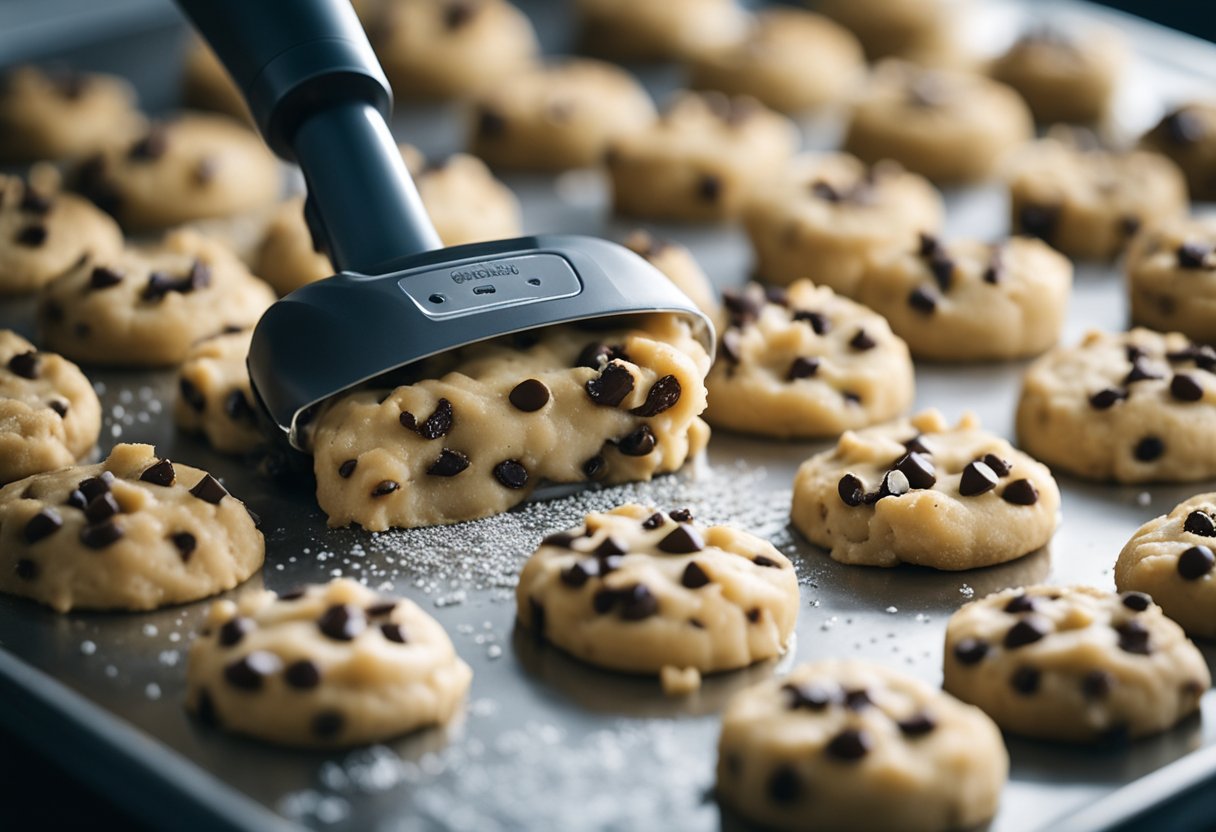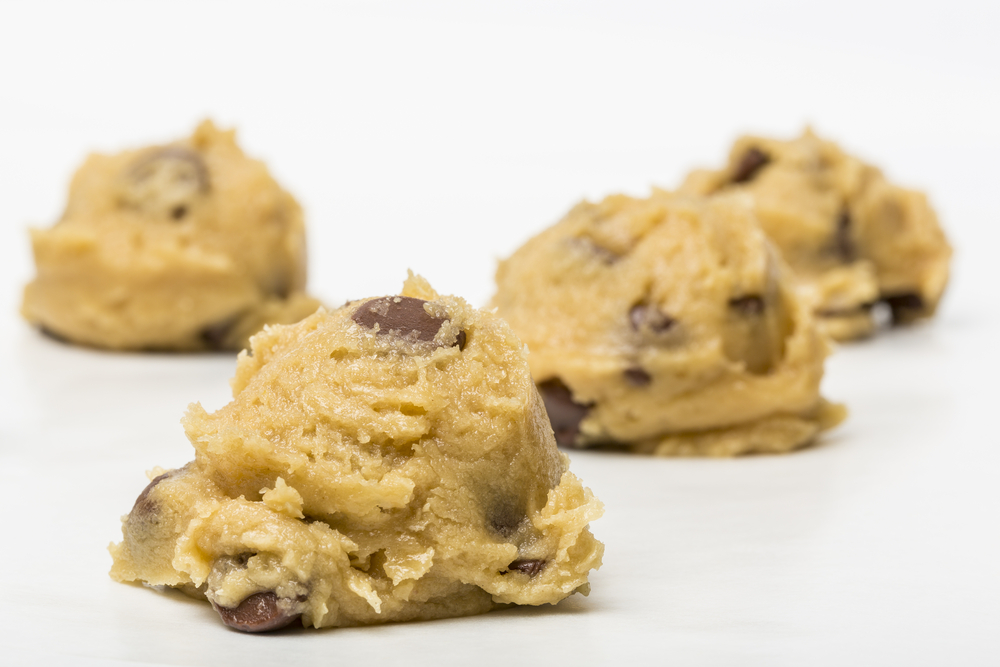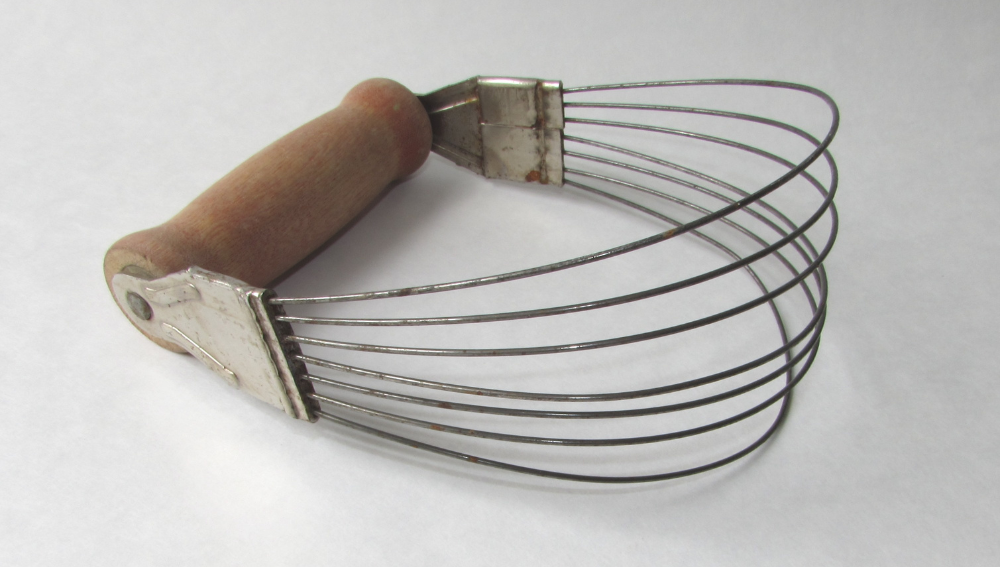Thawing cookie dough is an essential step in the baking process. Frozen cookie dough can be stored for months, making it a convenient option for busy bakers.
However, it’s crucial to know how to thaw cookie dough correctly to ensure the best results.

Understanding frozen cookie dough is the first step in learning how to thaw it properly. Frozen cookie dough can be stored in the freezer for up to three months, depending on the recipe.
Different types of cookie dough may require different thawing methods, so it’s essential to read the recipe carefully before beginning the thawing process.
There are several methods to thaw cookie dough, including the refrigerator, room temperature, and the microwave.
Each method has its benefits and drawbacks, so it’s essential to choose the right one for your recipe. With the right method and preparation, you can ensure that your cookie dough is thawed correctly and ready for baking.
Key Takeaways
- Understanding frozen cookie dough is crucial for proper thawing.
- There are several methods to thaw cookie dough, including the refrigerator, room temperature, and the microwave.
- Choosing the right thawing method and preparation is essential for successful baking.
Understanding Frozen Cookie Dough
As a baker, I know how important it is to have a stash of cookie dough in the freezer for those last-minute baking needs.
Frozen cookie dough can be a lifesaver when you need to whip up a batch of cookies quickly. However, it’s important to know how to properly freeze and thaw cookie dough to ensure the best results.
Freezing cookie dough is a great way to extend its shelf life. However, it’s important to freeze it properly to prevent freezer burn and maintain the dough’s quality.
To freeze cookie dough, wrap it tightly in plastic wrap or aluminum foil, or place it in an airtight container. Be sure to label the container with the date and type of dough, so you can easily identify it later.
When it comes to thawing frozen cookie dough, there are a few methods to choose from. The most common methods are thawing in the refrigerator, at room temperature, or in the microwave.
Thawing in the refrigerator is the safest method, as it allows the dough to thaw slowly and evenly. This method can take several hours or overnight, so be sure to plan ahead.
If you’re in a hurry, you can thaw the dough at room temperature. However, this method can be risky, as it can cause the dough to thaw unevenly and increase the risk of bacterial growth.
To thaw at room temperature, place the dough on a plate or tray and cover it with plastic wrap. Be sure to check the dough frequently and transfer it to the refrigerator if it starts to feel too soft.
Thawing frozen cookie dough in the microwave is the quickest method, but it can also be the riskiest. Microwaves can cause the dough to become too soft or even start to cook, which can affect the dough’s texture and flavor.
To thaw in the microwave, use the defrost setting and check the dough every 30 seconds to prevent overcooking.
Overall, freezing cookie dough is a great way to save time and extend the shelf life of your dough. Just be sure to freeze and thaw it properly to maintain its quality and ensure the best results.
Methods to Thaw Cookie Dough

Thawing cookie dough is a crucial step in the baking process. There are several methods to thaw cookie dough, and each method has its advantages and disadvantages.
In this section, I will discuss some of the most common methods to thaw cookie dough.
Refrigerator Thawing
Refrigerator thawing is the most recommended method to thaw cookie dough. It is a gentle and controlled process that preserves the dough’s texture and flavor.
To thaw cookie dough in the refrigerator, place the dough in a sealed container or a plastic bag and put it in the fridge. The dough will thaw slowly, and it may take up to 24 hours for the dough to thaw completely.
Room Temperature Thawing
Thawing cookie dough at room temperature is not recommended because it can lead to the growth of harmful bacteria. However, if you are in a hurry, you can thaw the dough at room temperature.
To thaw cookie dough at room temperature, take the dough out of the freezer and place it on the kitchen counter.
The dough will thaw faster than in the refrigerator, but it is important to monitor the dough’s temperature to ensure that it does not reach room temperature.
Microwave Thawing
Microwave thawing is the fastest way to thaw cookie dough, but it can also lead to uneven thawing and cooking. To thaw cookie dough in the microwave, place the dough in a microwave-safe container and set the microwave to defrost mode.
Microwave the dough in 30-second intervals, turning the dough after each interval until it is thawed.
Bake from Frozen
If you are in a rush and don’t have time to thaw the dough, you can bake the dough from frozen. To bake cookie dough from frozen, preheat the oven to the required temperature and place the frozen dough on a baking sheet.
Bake the dough for a few minutes longer than the recipe requires, and monitor the dough’s temperature to ensure that it is cooked through.
In conclusion, there are several methods to thaw cookie dough, each with its advantages and disadvantages. Refrigerator thawing is the most recommended method for thawing cookie dough, but if you are in a hurry, you can use the microwave or bake the dough from frozen.
However, it is important to monitor the dough’s temperature to ensure that it is cooked through and safe to eat.
Thawing Cookie Dough in the Refrigerator

Thawing cookie dough in the refrigerator is the safest and most recommended method. It ensures that the dough is thawed evenly and at a safe temperature, minimizing the risk of bacterial growth.
Here are some important things to keep in mind when thawing cookie dough in the refrigerator.
Thawing Time in the Fridge
The thawing time in the fridge depends on the size and thickness of the cookie dough. Typically, it takes about 24 to 48 hours for the dough to thaw completely in the fridge.
It is important to plan ahead and give yourself enough time to thaw the dough before you plan to bake it.
If you are short on time, you can try cutting the dough into smaller pieces or flattening it out before placing it in the fridge. This will help speed up the thawing process.
However, make sure that the dough is still wrapped tightly in plastic wrap or a freezer bag to prevent it from drying out or absorbing odors from the fridge.
Avoiding Bacteria Growth
When thawing cookie dough in the refrigerator, it is important to follow proper food safety guidelines to avoid the growth of harmful bacteria. Here are some tips to keep in mind:
- Always thaw cookie dough on the bottom shelf of the fridge, away from any ready-to-eat foods.
- Make sure that the dough is wrapped tightly in plastic wrap or a freezer bag to prevent any drips or leaks.
- Do not refreeze cookie dough that has been thawed in the fridge. Once it has thawed, it should be baked within a few days.
- Wash your hands and any surfaces that come into contact with the dough before and after handling it.
- Always use a food thermometer to ensure that the cookie dough reaches a safe internal temperature of 165°F (74°C) before consuming.
By following these tips, you can safely thaw cookie dough in the fridge and enjoy delicious freshly baked cookies without any worries.
Thawing Cookie Dough at Room Temperature

Thawing cookie dough at room temperature is a quick and easy method that requires minimal effort.
However, it is important to note that this method is not suitable for all types of cookie dough, especially those that contain perishable ingredients such as eggs or dairy.
To thaw cookie dough at room temperature, simply remove it from the freezer and place it on a clean, dry surface.
It is important to keep the dough wrapped in plastic wrap or airtight container to prevent it from drying out or absorbing any odors from the surrounding environment.
The time it takes for the dough to thaw at room temperature depends on various factors such as the size and thickness of the dough, the temperature of the room, and the humidity level.
Generally, it takes anywhere from 30 minutes to 2 hours for the dough to thaw completely.
It is important to monitor the dough while it is thawing to ensure that it does not become too soft or sticky.
If the dough starts to become too soft, place it back in the refrigerator for a few minutes to firm up before continuing to thaw at room temperature.
Thawing cookie dough at room temperature is a convenient method, but it is important to handle the dough with care to prevent any contamination or spoilage.
Always wash your hands and any utensils used in the process to maintain proper food safety.
| Pros | Cons |
|---|---|
| Quick and easy | Not suitable for all types of cookie dough |
| Minimal effort required | Time to thaw can vary |
| Convenient method | Dough can become too soft or sticky |
| No special equipment required | Requires careful handling to prevent contamination |
Using a Microwave to Thaw Cookie Dough
When it comes to thawing cookie dough, using a microwave is one of the quickest and most convenient methods. Here’s how I do it:
- First, I take the frozen cookie dough out of the freezer and place it in a microwave-safe container or bag. It’s important to make sure the container is microwave-safe to avoid any potential hazards.
- Next, I set the microwave to defrost mode or the lowest power setting available. I usually start with 30-second intervals and check the dough after each interval to avoid overcooking it.
- If the dough is still too hard after the first 30 seconds, I repeat the process until it has thawed to the desired consistency.
It’s important to note that microwaving cookie dough can cause it to become soft and sticky, making it difficult to handle.
To avoid this, I recommend placing the dough in the refrigerator for a few minutes after thawing to firm it up before baking.
One thing to keep in mind is that microwaving times may vary depending on the microwave’s power and the amount of dough being thawed. It’s always a good idea to check the dough frequently to avoid overcooking or overheating it.
Overall, using a microwave to thaw cookie dough is a quick and easy method that can save time in the kitchen. Just be sure to follow these steps carefully to ensure your dough is thawed properly and ready to bake.
Preparation for Baking

Before baking your cookie dough, it’s important to properly prepare your baking sheet and oven. Here are some tips to ensure your cookies turn out perfectly:
Preparing the Baking Sheet
First, line your baking sheet with parchment paper. This will prevent the cookies from sticking to the sheet and make cleanup easier. If you don’t have parchment paper, you can also use a non-stick baking mat or grease the sheet with cooking spray.
Next, make sure to space out your cookie dough balls evenly on the sheet. Leave about 2 inches of space between each ball to allow for spreading during baking. If you’re using a smaller sheet, you may need to bake the cookies in batches.
Preheating the Oven
It’s important to preheat your oven to the correct temperature before baking your cookies. This ensures that the cookies will bake evenly and prevents them from spreading too much.
Most cookie recipes call for a temperature of 350°F, but be sure to check your recipe for specific instructions. Preheat your oven for at least 10 minutes before baking to ensure it reaches the correct temperature.
Once your oven is preheated, place the baking sheet on the center rack and set the timer according to your recipe. Keep an eye on the cookies as they bake, and remove them from the oven when they’re golden brown and slightly firm to the touch.
By properly preparing your baking sheet and preheating your oven, you’ll be well on your way to baking delicious, perfectly cooked cookies.
Baking the Thawed Cookie Dough

Now that your cookie dough has thawed, it’s time to bake it! Baking the thawed cookie dough is a simple process that can be done in just a few steps.
First, preheat your oven to the temperature specified in your recipe. It’s important to preheat your oven so that the cookies bake evenly and come out perfectly.
Next, prepare your baking sheet by lining it with parchment paper or a silicone baking mat. This will prevent the cookies from sticking to the baking sheet and make cleanup easier.
Then, scoop your thawed cookie dough onto the prepared baking sheet. Make sure to leave enough space between each cookie, as they will spread while baking.
Once your cookies are on the baking sheet, place it in the preheated oven and bake according to the instructions in your recipe.
Keep a close eye on the cookies while they bake, as the baking time may vary depending on the size and thickness of the cookies.
When the cookies are done baking, remove them from the oven and let them cool on the baking sheet for a few minutes before transferring them to a wire rack to cool completely.
This will allow the cookies to set and prevent them from breaking apart.
And there you have it! Your thawed cookie dough has been transformed into delicious, fresh-baked cookies. If you have any leftover cookies, they can be stored in an airtight container at room temperature for up to a week.
Remember, baking frozen cookie dough is a great way to have fresh-baked cookies on hand anytime.
Whether you bake from frozen or thaw your cookie dough first, the end result will be delicious, homemade cookies that are sure to impress.
Different Types of Cookie Dough

When it comes to cookie dough, there are a variety of types to choose from depending on your taste preferences. Here are some of the most popular types of cookie dough:
Chocolate Chip Cookie Dough
Chocolate chip cookie dough is a classic favorite. It’s made with a combination of flour, sugar, butter, eggs, and of course, chocolate chips.
This dough can be frozen and thawed easily, making it a great option for those who want to have fresh-baked cookies on hand at all times.
Sugar Cookie Dough
Sugar cookie dough is a versatile dough that can be used to make a variety of different types of cookies. It’s made with flour, sugar, butter, eggs, and vanilla extract.
This dough can be rolled out and cut into shapes, making it perfect for holiday cookies or any other occasion.
Drop Cookies Dough
Drop cookies are a type of cookie that are made by dropping spoonfuls of dough onto a baking sheet.
This dough is typically softer than other types of cookie dough, making it easier to scoop and drop onto the baking sheet. It’s a great option for those who want to make cookies quickly and easily.
Madeleines Dough
Madeleines are a type of cookie that are traditionally French. They are made with flour, sugar, butter, eggs, and lemon zest.
The dough is piped into a special madeleine mold and baked until golden brown. Madeleines are perfect for serving with tea or coffee.
Meringues Dough
Meringues are a type of cookie that are made with egg whites and sugar. The dough is whipped until stiff peaks form and then piped onto a baking sheet.
Meringues can be flavored with vanilla extract or other extracts to add flavor. They are perfect for those who want a low-fat cookie option.
Overall, there are many different types of cookie dough to choose from. Whether you prefer chocolate chip cookies, sugar cookies, drop cookies, madeleines, or meringues, there is a dough that will suit your taste preferences.
Homemade cookies are a great way to satisfy your sweet tooth, and with so many options to choose from, you’ll never get bored!
Storing Cookie Dough
When it comes to storing cookie dough, there are a few things to keep in mind to ensure the dough stays fresh and delicious. Here are some tips on how to store cookie dough properly.
Using Plastic Wrap
One way to store cookie dough is by using plastic wrap. This method works well for short-term storage, such as when you want to chill the dough for a few hours or overnight.
To use plastic wrap, simply shape the dough into a disk or log and wrap it tightly with plastic wrap. Make sure there are no air pockets, as this can cause the dough to dry out and become freezer burned.
Once wrapped, place the dough in the refrigerator or freezer. If storing in the freezer, it’s a good idea to label the dough with the date and type of cookie dough to avoid confusion later on.
Airtight Containers
Another way to store cookie dough is by using airtight containers. This method is great for long-term storage, as it helps to prevent freezer burn and keeps the dough fresh for several months.
To use an airtight container, shape the dough into a disk or log and place it in the container. Make sure the lid is tightly sealed to prevent air from getting in.
When storing in the freezer, it’s a good idea to place the container in a plastic bag to provide an extra layer of protection against freezer burn.
Overall, whether you choose to use plastic wrap or an airtight container, it’s important to keep cookie dough properly stored to ensure it stays fresh and delicious.
By following these tips, you can enjoy fresh-baked cookies whenever you want, without the hassle of making dough from scratch every time.
Health Considerations

When it comes to thawing cookie dough, there are some health considerations to keep in mind. As with any food, there is a risk of food poisoning if proper precautions are not taken.
One of the most important things to keep in mind is the temperature of the dough. Bacteria can grow quickly at room temperature, so it is important to thaw the dough in the refrigerator or microwave, rather than leaving it out on the counter.
It is also important to make sure that the dough is fully thawed before baking. If the dough is still partially frozen, it may not cook evenly, which can lead to undercooked dough and a risk of food poisoning.
Another consideration is the ingredients in the cookie dough. Some ingredients, such as raw eggs, can carry a risk of salmonella. If you are using a recipe that calls for raw eggs, be sure to use pasteurized eggs to reduce the risk of food poisoning.
Overall, it is important to take proper precautions when thawing and baking cookie dough to ensure that it is safe to eat. By following these guidelines, you can enjoy delicious homemade cookies without putting your health at risk.
Final Thoughts
After exploring various ways to thaw cookie dough, I have come to the conclusion that the best method is to thaw it in the refrigerator overnight.
It may take longer, but it is the safest method to avoid any potential issues with food poisoning.
If you are in a hurry and need to thaw the cookie dough quickly, you can use the defrost function on your microwave. However, be careful not to overheat the dough as it can start to cook and become unusable.
It’s important to note that you do not need to thaw cookie dough at all. Frozen cookie dough can be baked directly in the oven without thawing, but it may require a few extra minutes of baking time.
If you plan to freeze cookie dough, it’s best to shape it into individual portions or slice-and-bake cookies before freezing. This makes it easier to thaw and bake them later.
When baking frozen cookie dough, it’s important to preheat the oven to the recommended temperature and add a few extra minutes to the baking time. This ensures that the cookies are fully cooked and have a crispy texture.
In summary, the safest and most effective way to thaw cookie dough is to do it in the refrigerator overnight. However, if you need to thaw it quickly, you can use the defrost function on your microwave.
Remember that you can also bake frozen cookie dough directly in the oven without thawing it first. Just make sure to adjust the baking time accordingly.
Frequently Asked Questions
What is the best way to defrost frozen cookie dough?
The best way to defrost frozen cookie dough is by placing it in the refrigerator overnight. This method ensures a slow and controlled thawing process, preserving the dough’s texture and flavor.
You can also thaw the dough at room temperature or in the microwave, but these methods may affect the quality of the dough.
How long does it take to thaw cookie dough in the fridge?
It usually takes around 6 to 8 hours to thaw cookie dough in the fridge. However, the exact time may vary depending on the amount and thickness of the dough.
It’s recommended to plan ahead and thaw the dough overnight to ensure it’s fully thawed before using it.
Can you bake frozen cookie dough without thawing it first?
Yes, you can bake frozen cookie dough without thawing it first. Simply preheat your oven to the recommended temperature, place the frozen dough on a baking sheet, and bake for a few extra minutes than the recipe calls for.
However, keep in mind that the cookies may not spread as much as they would if the dough was thawed first.
How do you quickly defrost cookie dough?
If you need to quickly defrost cookie dough, you can use the microwave or place it in a bowl of cold water. To thaw in the microwave, remove the dough from its packaging and place it on a microwave-safe plate.
Microwave on the defrost setting for 30-second intervals, flipping the dough over between each interval, until it’s thawed.
To thaw in cold water, place the dough in a sealed plastic bag and submerge it in a bowl of cold water. Change the water every 30 minutes until the dough is thawed.
Is it safe to thaw cookie dough at room temperature?
While it’s possible to thaw cookie dough at room temperature, it’s not recommended as it can increase the risk of bacterial growth and spoilage. If you need to thaw the dough quickly, use the microwave or cold water method instead.
Can you refrigerate cookie dough after it has been thawed?
Yes, you can refrigerate cookie dough after it has been thawed. However, it’s important to use it within 2 to 3 days to ensure it’s still fresh and safe to eat.
If you don’t plan on using the dough right away, it’s best to freeze it again until you’re ready to bake.







